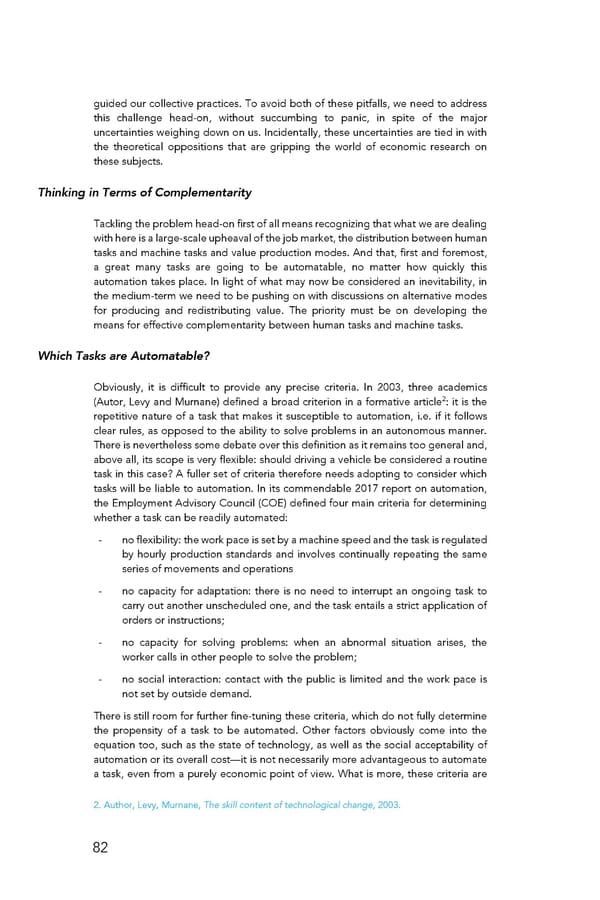guided our collective practices. To avoid both of these pitfalls, we need to address this challenge head-on, without succumbing to panic, in spite of the major uncertainties weighing down on us. Incidentally, these uncertainties are tied in with the theoretical oppositions that are gripping the world of economic research on these subjects. Thinking in Terms of Complementarity Tackling the problem head-on first of all means recognizing that what we are dealing with here is a large-scale upheaval of the job market, the distribution between human tasks and machine tasks and value production modes. And that, first and foremost, a great many tasks are going to be automatable, no matter how quickly this automation takes place. In light of what may now be considered an inevitability, in the medium-term we need to be pushing on with discussions on alternative modes for producing and redistributing value. The priority must be on developing the means for effective complementarity between human tasks and machine tasks. Which Tasks are Automatable? Obviously, it is difficult to provide any precise criteria. In 2003, three academics (Autor, Levy and Murnane) defined a broad criterion in a formative article2: it is the repetitive nature of a task that makes it susceptible to automation, i.e. if it follows clear rules, as opposed to the ability to solve problems in an autonomous manner. There is nevertheless some debate over this definition as it remains too general and, above all, its scope is very flexible: should driving a vehicle be considered a routine task in this case? A fuller set of criteria therefore needs adopting to consider which tasks will be liable to automation. In its commendable 2017 report on automation, the Employment Advisory Council (COE) defined four main criteria for determining whether a task can be readily automated: - no flexibility: the work pace is set by a machine speed and the task is regulated by hourly production standards and involves continually repeating the same series of movements and operations - no capacity for adaptation: there is no need to interrupt an ongoing task to carry out another unscheduled one, and the task entails a strict application of orders or instructions; - no capacity for solving problems: when an abnormal situation arises, the worker calls in other people to solve the problem; - no social interaction: contact with the public is limited and the work pace is not set by outside demand. There is still room for further fine-tuning these criteria, which do not fully determine the propensity of a task to be automated. Other factors obviously come into the equation too, such as the state of technology, as well as the social acceptability of automation or its overall cost—it is not necessarily more advantageous to automate a task, even from a purely economic point of view. What is more, these criteria are 2. Author, Levy, Murnane, The skill content of technological change, 2003. 82
 For a Meaningful AI - Report Page 82 Page 84
For a Meaningful AI - Report Page 82 Page 84